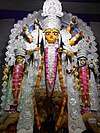Baul
The Baul or Bauls (Bengali: বাউল) are a group of mystic minstrels of mixed elements of Sufism and Vaishnavism from Bengal region, comprising Bangladesh and the Indian states of West Bengal, Tripura and Barak Valley. Bauls constitute both a syncretic religious sect and a musical tradition. Bauls are a very heterogeneous group, with many sects, but their membership mainly consists of Vaishnava Hindus and Sufi Muslims.[1][2] They can often be identified by their distinctive clothes and musical instruments. Lalon Shah is regarded as the most celebrated Baul saint in history.[3][4][5]
| Baul songs | |
|---|---|
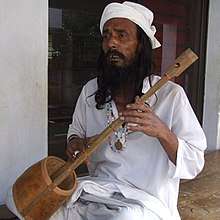 | |
| Country | Bangladesh |
| Domains | Social practices, rituals and festive events |
| Reference | 00107 |
| Region | Asia and the Pacific |
| Inscription history | |
| Inscription | 2008 (3rd session) |
| List | Representative |
 | |
| Part of a series on the |
| Culture of Bengal |
|---|
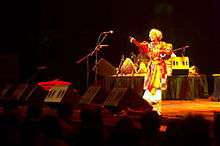 |
| History |
|
|
Mythology and folklore |
| Cuisine |
|
Festivals
|
|
Genres
Institutions
Awards
|
|
Music and performing arts Folk genres Devotional Classical genres
Modern genres
People Instruments Dance Theater
Organizations People |
|
Sport
|
|
|
| Part of a series on |
| Bengalis |
|---|
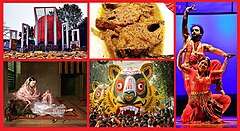 |
|
Bengali homeland |
|
Bengali culture
|
|
Bengali symbols |
Although Bauls comprise only a small fraction of the Bengali population, their influence on the culture of Bengal is considerable. In 2005, the Baul tradition of Bangladesh was included in the list of Masterpieces of the Oral and Intangible Heritage of Humanity by UNESCO.[6]
Etymology
The origin of the word Baul is debated. Some modern scholars, like Shashibhusan Dasgupta have suggested that it may be derived either from Sanskrit word vātula, which means "enlightened, lashed by the wind to the point of losing one's sanity, god's madcap, detached from the world, and seeker of truth", or from vyākula, which means "restless, agitated" and both of these derivations are consistent with the modern sense of the word, which denotes the inspired people with an ecstatic eagerness for a spiritual life, where a person can realise his union with the eternal beloved – the Moner Manush (the person of the heart).[7]
History
The origin of Bauls is not known exactly, but the word "Baul" has appeared in Bengali texts as old as the 15th century. The word is found in the Chaitanya Bhagavata of Vrindavana Dasa Thakura as well as in the Chaitanya Charitamrita of Krishnadasa Kaviraja.[8] Some scholars maintain that it is not clear when the word took its sectarian significance, as opposed to being a synonym for the word madcap, agitated. Bauls are a part of the culture of rural Bengal. Many attempts have been made to ascertain the origin of Bauls but there is wide disagreement among scholars.[9] But they agree that no founders have been acknowledged either by Bauls themselves or others.[10] Bauls are divided into several named groups, each following a named Hindu or Muslim guru. Besides, there are other communities who later identified or affiliated themselves with Bauls, like Darbesi, Nera and two sub-sects of Kartabhajas — Aul and Sai. The Bauls themselves attribute their lack of historical records to their reluctance to leave traces behind. Dr. Jeanne Openshaw writes that the music of the Bauls appears to have been passed down entirely in oral form until the end of the 19th century, when it was first transcribed by outside observers.[10]
There are two classes of Bauls: ascetic Bauls who reject family life and Bauls who live with their families. Ascetic Bauls renounce family life and society and survive on alms. They have no fixed dwelling place, but move from one akhda to another. Men wear white lungis and long, white tunics; women wear white saris. They carry jholas, shoulder bags for alms. They do not beget or rear children. They are treated as jyante mara or dalits. Women dedicated to the service of ascetics, are known as sevadasis "service slaves". A male Baul can have one or more sevadasis, who are associated with him in the act of devotion. Until 1976 the district of Kushtia had 252 ascetic Bauls. In 1982-83 the number rose to 905; in 2000, they numbered about 5000.
Those who choose family life live with their spouse, children and relations in a secluded part of a village. They do not mix freely with other members of the community. Unlike ascetic Bauls, their rituals are less strict. In order to become Bauls, they recite some mystic verses and observe certain rituals.[11]
Concepts and practices

Baul music celebrates celestial love, but does this in very earthy terms, as in declarations of love by the Baul for his bosh-tomi or lifemate. With such a liberal interpretation of love, it is only natural that Baul devotional music transcends religion and some of the most famous baul composers, such as Lalon, criticised the superficiality of religious divisions:
Everyone asks: "Lalan, what's your religion in this world?"
Lalan answers: "How does religion look?"
I've never laid eyes on it.
Some wear malas [Hindu rosaries] around their necks,
some tasbis [Muslim rosaries], and so people say
they've got different religions.
But do you bear the sign of your religionwhen you come or when you go?[12]
The famous Bengali poet Rabindranath Tagore was greatly influenced and inspired by Bauls. Here is a famous Rabindra Sangeet heavily influenced by Baul theme:
amar praner manush achhe prane
tai here taye shokol khane
Achhe she noyōn-taray, alōk-dharay, tai na haraye--
ogo tai dekhi taye Jethay shethay
taka-i ami je dik-paneThe man of my heart dwells inside me.
Everywhere I look, it is he.
In my every sight, in the sparkle of light
Oh, I can never lose him--
Here, there and everywhere,Wherever I turn, he is right there!
Their religion is based on an expression of the body (deho sādhana), and an expression of the mind (mana sādhana). Some of their rituals are kept hidden from outsiders, as they might be thought to be repulsive or hedonistic. Bauls concentrate much of their mystic energies on the four body fluids, on the nine-doors (openings of the body), on prakṛti as "nature" or "primal motive force", and on breath sādhana.
Music

The music of the Bauls, Baul Sangeet, is a particular type of folk song. Their music represents a long heritage of preaching mysticism through songs in Bengal.
Bauls pour out their feelings in their songs but never bother to write them down. Theirs is essentially an oral tradition. It is said that Lalon Fokir (1774 -1890), the greatest of all Bauls, continued to compose and sing songs for decades without ever stopping to correct them or put them on paper. It was only after his death that people thought of collecting and compiling his repertoire.
Their lyrics intertwine a deep sense of mysticism, a longing for oneness with the divine. An important part of their philosophy is "Deha tatta", a spirituality related to the body rather than the mind. They seek the divinity in human beings. Metaphysical topics are dwelt upon humbly and in simple words. They stress remaining unattached and unconsumed by the pleasures of life even while enjoying them. To them we are all a gift of divine power and the body is a temple, music being the path to connect to that power.[13][14] A consistent part of Bauls' lyrics deals with body-centered practices that aim at controlling sexual desire. The esoteric knowledge of conception and contraception is revealed in the lyrics of the songs through an enigmatic language that needs to be decoded by the guru in order to be understood and experienced.[15]
Besides traditional motifs drawn from the rural everyday life, Baul songs have always been inclined to incorporate change and keep pace with social and economic innovations. For instance, modern Baul compositions discuss esoteric matters by using the terminology of modern, urban and technological lexicons, and it is not unusual to hear Baul refrains containing mobile phones, radio channels, football matches and television.[16]
Bauls use a number of musical instruments: the most common is the ektara, a one-stringed "plucked drum" drone instrument, carved from the epicarp of a gourd, and made of bamboo and goatskin. Others include the dotara, a long-necked fretless lute (while the name literally means "two stringed" it usually has four metal strings) made of the wood of a jackfruit or neem tree; besides khamak, one-headed drum with a string attached to it which is plucked. The only difference from ektara is that no bamboo is used to stretch the string, which is held by one hand, while being plucked by another.[17] Drums like the duggi, a small hand-held earthen drum, and dhol and khol; small cymbals called khartal and manjira, and the bamboo flute are also used. Ghungur and nupur are anklets with bells that ring while the person wearing them dances.
A Baul family played on stage in London for The Rolling Stones' Hyde Park concerts in 1971, '72 and '78 in front of thousands.[14]
Influence on Rabindranath Tagore
The songs of the Bauls and their lifestyle influenced a large swath of Bengali culture, but nowhere did it leave its imprint more powerfully than on the work of Rabindranath Tagore, who talked of Bauls in a number of speeches in Europe in the 1930s. An essay based on these was compiled into his English book The Religion of Man:
The Bauls are an ancient group of wandering minstrels from Bengal, who believe in simplicity in life and love. They are similar to the Buddhists in their belief in a fulfillment which is reached by love's emancipating us from the dominance of self.
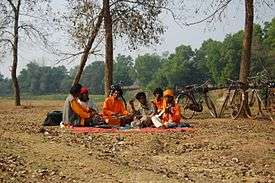
Where shall I meet him, the Man of my Heart?
He is lost to me and I seek him wandering from land to land.
- I am listless for that moonrise of beauty,
- which is to light my life,
- which I long to see in the fullness of vision
- in gladness of heart. [p.524]
The above is a translation of the famous Baul song by Gagan Harkara: Ami kothai pabo tare, amar moner manush je re. The following extract is a translation of another song:
My longing is to meet you in play of love, my Lover;
But this longing is not only mine, but also yours.
For your lips can have their smile, and your flute
- its music, only in your delight in my love;
- and therefore you importunate, even as I am.
The poet proudly says: 'Your flute could not have its music of beauty if your delight were not in my love. Your power is great—and there I am not equal to you—but it lies even in me to make you smile and if you and I never meet, then this play of love remains incomplete.'
The great distinguished people of the world do not know that these beggars—deprived of education, honour and wealth—can, in the pride of their souls, look down upon them as the unfortunate ones who are left on the shore for their worldly uses but whose life ever misses the touch of the Lover's arms.
This feeling that man is not a mere casual visitor at the palace-gate of the world, but the invited guest whose presence is needed to give the royal banquet its sole meaning, is not confined to any particular sect in India.
A large tradition in medieval devotional poetry from Rajasthan and other parts of India also bear the same message of unity in celestial and romantic love and that divine love can be fulfilled only through its human beloved.
Tagore's own compositions were powerfully influenced by Baul ideology. His music also bears the stamp of many Baul tunes. Other Bengali poets, such as Kazi Nazrul Islam, have also been influenced by Baul music and its message of non-sectarian devotion through love.
Rabindranath Tagore was greatly influenced and inspired by Bauls. Here is a famous Rabindrasangeet (Tagore song), heavily influenced by Baul theme:
Amar praner manush achhé prané
Tai heri taye sakol khane
Achhe shé nayōntaray, alōk-dharay, tai na haraye--
- Ogo tai dekhi taye jethay sethay
- Taka-i ami jé dik-pané
The man of my heart dwells inside me.
Everywhere I behold, it's Him!
In my every sight, in the sparkle of light
- Oh I can never lose Him --
- Here, there and everywhere,
- Wherever I turn, right in front is He![18]
All bāulas shared only one belief in common—that God is hidden within the heart of man and neither priest, prophet, nor the ritual of any organized religion will help one to find Him there. They felt that both temple and mosque block the path to truth; the search for God must be carried out individually and independently.[19]
Present status

Bauls are found in the Indian state of West Bengal and the eastern parts of Bihar and Jharkhand and the country of Bangladesh. The Baul movement was at its peak in the 19th and early 20th centuries, but even today one comes across the occasional Baul with his Ektara (one-stringed musical instrument) and begging bowl, singing across the far-flung villages of rural Bengal. Travelling in local trains and attending village fairs are good ways to encounter Bauls.
Every year, in the month of Falgun (February to March), "Lalon Smaran Utshab" (Lalon memorial festival) is held in the shrine of Lalon in Kushtia, Bangladesh, where bauls and devotees of Lalon from Bangladesh and overseas come to perform and highlight the mystics of Lalon.[20]
Palli Baul Samaj Unnayan Sangstha (PBSUS), a Bangladeshi organisation, has been working to uphold and preserve the 'baul' traditions and philosophy for the last nine years. The organisation often arranges programmes featuring folk songs for urban audiences.[21]
Bangladesh Shilpakala Academy often organises national and international festivals and seminars, featuring the Baul music and the importance of preservation of Baul tradition.
In the village of Jaydev Kenduli, a Mela (fair) is organised in memory of the poet Jayadeva on the occasion of Makar Sankranti in the month of Poush. So many Bauls assemble for the mela that it is also referred to as "Baul Fair".
In the village of Shantiniketan during Poush Mela, numerous Bauls also come together to enthral people with their music.
For the last five years, a unique show has been organised in Kolkata, called "Baul Fakir Utsav". Bauls from several districts of Bengal as well as Bangladesh come to perform. The Utsav is a continuous 48-hour musical experience.
There are also the Western Bauls in America and Europe under the spiritual direction of Lee Lozowick, a student of Yogi Ramsuratkumar. Their music is quite different (rock /gospel/ blues) but the essence of the spiritual practices of the East is well maintained.[22]
In Bangalore near Electronic City Dr. Shivshankar Bhattacharjee has started Boul Sammelon (Gathering of Baulls) on 7–9 April-2017 on the occasion of the inauguration of Sri Sri Kali Bari (Goodness Kali's Temple). First time it held in Bangalore to embrace the Boul culture. More that 50 Bouls participated and sang soulful songs.
Currently another version of Baul called the folk fusion also called baul rock is also greatly accepted by the audience, especially in West Bengal. Kartik das baul being a traditional folk singer, who has taken baul to different heights is being associated with folk fusion. This type of baul was brought into the world of music by Bolepur bluez.
Notable singers
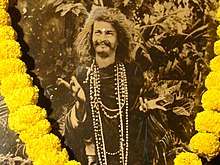
Lalon also known as Fakir Lalon Shah, Lalon Shah, Lalon Fakir (Bengali: লালন; 17 October 1774 – 17 October 1890; Bengali: 1 Kartik 1179) was a prominent Bengali philosopher, Baul saint, mystic, songwriter, social reformer and thinker. Regarded as an icon of Bengali culture, he inspired and influenced many poets, social and religious thinkers including Rabindranath Tagore, Kazi Nazrul Islam, and Allen Ginsberg although he "rejected all distinctions of caste and creed". Widely celebrated as an epitome of religious tolerance, he was also accused of heresy during his lifetime and after his death. In his songs, Lalon envisioned a society where all religions and beliefs would stay in harmony. He founded the institute known as Lalon Akhrah in Cheuriya, about 2 kilometres (1.2 mi) from Kushtia railway station. His disciples dwell mostly in Bangladesh and West Bengal. Every year on the occasion of his death anniversary, thousands of his disciples and followers assemble at Lalon Akhrah, and pay homage to him through celebration and discussion of his songs and philosophy for three days.
Shah Abdul Karim (15 February 1916 – 12 September 2009) was a Bangladeshi Baul musician. Dubbed "Baul Samrat", he was awarded the Ekushey Padak in 2001 by the Government of Bangladesh. Some of his notable songs include Keno Piriti Baraila Re Bondhu, Murshid Dhono He Kemone Chinibo Tomare, Nao Banailo Banailo Re Kon Mestori, Ashi Bole Gelo Bondhu and Mon Mojale Ore Bawla Gaan. He referred to his compositions as Baul Gaan.[23]
Bhaba Pagla (1902-1984) was a famous saint-composer and an important guru from East Bengal. He has been a spiritual preceptor for many Bauls and his songs are very popular among Baul performers.[24]
See also
Notes
- "Baul (Indian music)". Encyclopædia Britannica Online. 18 June 2015.
- "Bauled over". The Times of India. 6 February 2010.
- Multiple editors (2007). World and its People: Eastern and Southern Asia. New York: Marshal Cavendish Corporation. p. 480. ISBN 978-0-7614-7631-3.
- Paul, Harendra Chandra (1987). "Origin of the Bauls and their Philosophy". In Khan, Shamsuzzaman (ed.). Folklore of Bangladesh. Volume 1. Dhaka: Bangla Academy. p. 257.
Faquir Lalan-Shah (1775–1891 A.D.), its greatest exponent
- Chowdhury, Kabir (1985). Folk Poems From Bangladesh. Dhaka: Bangla Academy. pp. ii.
- Masterpieces of the Oral and Intangible Heritage of Humanity. UNESCO. 25 September 2005.
- Das Gupta, Shashibhusan (1946, reprint 1995). Obscure Religious Cults, Calcutta: Firma KLM, ISBN 81-7102-020-8, pp.160-1
- Das Gupta, Shashibhusan (1946, reprint 1995). Obscure Religious Cults, Calcutta: Firma KLM, ISBN 81-7102-020-8, p.160ff
- Openshaw, Jeanne (2002). Seeking Bauls of Bengal. Cambridge University Press. p. 58. ISBN 978-0-521-81125-5.
- Openshaw, Jeanne (2002). Seeking Bauls of Bengal. Cambridge University Press. p. 56. ISBN 978-0-521-81125-5.
- Karim, Anwarul (2012). "Baul". In Islam, Sirajul; Jamal, Ahmed A. (eds.). Banglapedia: National Encyclopedia of Bangladesh (Second ed.). Asiatic Society of Bangladesh.
- Lopez, Donald (1995). Religions in India in Practice - "Baul Songs". Princeton, NJ: Princeton University Press. pp. 187–208. ISBN 0-691-04324-8.
- "Bauls of Bengal". Hinduism.about.com. 10 April 2012. Retrieved 10 October 2012.
- Music (26 July 2011). "Bauls of Bengal – The Liberation Seekers". Emaho Magazine. Archived from the original on 29 July 2012. Retrieved 10 October 2012.
- Lorea, Carola (2014). "Why do you go swimming in the river full of algae? Conception and contraception in Baul songs and oral teachings". Journal of Folklore and Folkloristics. 7 (1): 9–45.
- Lorea, Carola Erika (January 2014). "Searching for the Divine, Handling Mobile Phones". History and Sociology of South Asia. 8 (1): 59–88. doi:10.1177/2230807513506629. ISSN 2230-8075.
- Dilip Ranjan Barthakur (2003). The Music And Musical Instruments of North Eastern India. Mittal Publications. pp. 130–. ISBN 978-81-7099-881-5. Retrieved 14 July 2013.
- "Bauls of Bangladesh". www.scribd.com
- Edward C. Dimock, Jr., "Rabindranath Tagore—'The Greatest of the Bāuls of Bengal,’" The Journal of Asian Studies (Ann Arbor, Mich.: Association for Asian Studies), vol. 19, no. 1 (Nov. 1959), 36–37.
- Aman, Amanur (13 March 2012). "Lalon Smaran Utshab ends". The Daily Star. Retrieved 10 October 2012.
- info@banglamusic.com (20 January 2012). "Baul Mela 2009 Bangla Music – Bangla Song Bangla Video Bengali Music Mp3 News". Banglamusic.com. Archived from the original on 18 October 2014. Retrieved 10 October 2012.
- Helen Crovetto, "Embodied Knowledge and Divinity: The Hohm Community as Western-style Bāuls," Nova Religio: The Journal of Alternative and Emergent Religions 10, no. 1 (August 2006): pp. 69-95.
- "'Baul king' Shah Abdul Karim buried". bdnews24.com. Retrieved 13 September 2019.
- 1987-, Lorea, Carola Erika (2016). Folklore, religion and the songs of a Bengali madman: a journey between performance and the politics of cultural representation. Leiden. ISBN 9789004324701. OCLC 950430793.CS1 maint: numeric names: authors list (link)
Bibliography
- Enamul Haq, Muhammad (1975), A history of Sufism in Bengal, Asiatic Society, Dhaka.
- Qureshi, Mahmud Shah (1977), Poems Mystiques Bengalis. Chants Bauls Unesco. Paris.
- Siddiqi, Ashraf (1977), Our Folklore Our Heritage, Dhaka.
- Karim, Anwarul (1980), The Bauls of Bangladesh. Lalon Academy, Kushtia.
- Mukherjee, Prithwindra (1981), Chants Caryâ du bengali ancien (édition bilingue), Le Calligraphe, Paris.
- Mukherjee, Prithwindra (1985), Bâul, les Fous de l'Absolu (édition trilingue), Ministère de la Culture/ Findakly, Paris
- Capwell, Charles (1986), The Music of the Bauls of Bengal. Kent State University Press, USA 1986. ISBN 0-87338-317-6.
- Dimock, Edward C. (1989), The Place of the Hidden Moon: Erotic Mysticism in the Vaisnava-Sahajiya Cult of Bengal, The University of Chicago Press, Chicago. ISBN 0-226-15237-5, ISBN 978-0-226-15237-0
- Bandyopadhyay, Pranab (1989), Bauls of Bengal. Firma KLM Pvt, Ltd., Calcutta.
- Mcdaniel, June (1989), The Madness of the Saints. Chicago.
- Sarkar, R. M. (1990), Bauls of Bengal. New Delhi.
- Brahma, Tripti (1990), Lalon : His Melodies. Calcutta.
- Gupta, Samir Das (2000), Songs of Lalon. Sahitya Prakash, Dhaka.
- Karim, Anwarul (2001), Rabindranath O Banglar Baul (in Bengali), Dhaka.
- Openshaw, Jeanne (2002). Seeking Bauls of Bengal. Cambridge University Press. ISBN 978-0-521-81125-5.
- Baul, Parvathy (2005). Song of the Great Soul: An Introduction to the Baul Path. Ekatara Baul Sangeetha Kalari.
- Capwell, Charles (2011), Sailing on the Sea of Love THE MUSIC OF THE BAULS OF BENGAL, The University of Chicago Press, Chicago. ISBN 978-0-85742-004-6
- Sen, Mimlu (2009), Baulsphere, Random House, ISBN 978-81-8400-055-9
- Sen, Mimlu (2010), The Honey Gatherers, Rider Books, ISBN 978-1-84604-189-1
- Knight, Lisa I. (2011). Contradictory Lives: Baul Women in India and Bangladesh. Oxford University Press. ISBN 978-0-19-977354-1.
- Mukherjee, Prithwindra (2014), Le Spontané: chants Caryâ et Bâul, Editions Almora, Paris.
References
|
|
External links
| Wikimedia Commons has media related to Baul. |
- Baul Archive Baularchive is dedicated to the memory of Professor Edward C. Dimock, Jr. who inspired generations of American and Bengali scholars with the poetry and philosophy of Baul songs. It is the culmination of Sally Grossman's forty-plus year long interest in the Bauls and has been conceived, inspired, and generously supported by her with the advice and cooperation of Charles Capwell.
- Lalon Song's Archive Lalon Song's Archive
